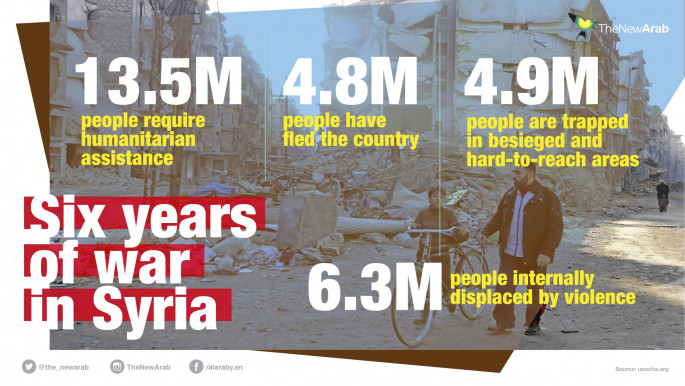Five years after Jordan's Za'atari refugee camp opened its doors, displaced Syrians still desperate
International NGOs marked the fifth anniversary of the Za'atari refugee camp opening its doors in north Jordan by renewing demands to help improve Syrian children's access to education.
An estimated 1.3 million Syrians are believed to have crossed the border into Jordan since civil war broke out more than six years ago.
"More pressure needs to be placed on the international community to follow through on their financial commitments to the Jordanian government," said Aya Abu Sitteh, a spokesperson for Save the Children in Jordan.
"Many countries made pledges to help support the Jordanian government in the long term - so they can help train teachers and deal with overcrowded classes."
In-depth: For Syrians in Jordan, higher eductaion remains a dream
Donor countries pledged close to $100 million in August to help alleviate conditions in the public school sector, overburdened by a huge increase in demand from the refugee community.
Yet not all of the donors have followed through on their promises, creating a large shortfall that the Jordanian ministry of education has found difficult to plug.
A missed opportunity
There were around 145,000 Syrian children who attended school in the previous school year, ending summer 2016, compared with an estimated 91,000 who didn't.
To help get these children into school, Jordan's education minister instructed public schools to allow Syrian children to register at the beginning of this school year - regardless of their legal documentation status.
Yet despite a 2016 pledge to get all Syrian refugee children into education by September 2017, the Jordanian government has only been able to provide places for around half.
In the 2016/17 school year, an additional 24,542 Syrian children were enrolled in formal education, less than half of the 50,000 newly allocated public school places.
 |
|
| [Click to enlarge] |
Many children had previously been turned away because they could not prove they had entered the country legally, while other children felt forced to work to provide an income for their families.
Around half of all Syrian households across Jordan rely on their children to work to provide an income for the family and many children are expected to grow up prematurely to survive.
A 2013 UN Women report on child protection among Syrian refugees in Jordan found that 51.3 percent of female and 13 percent of male respondents had married while still children.
The Jordanian government has agreed to provide work permits for more Syrian workers to help reduce families' reliance on child labour.
In the past year, the limit on annual work permits for Syrians was increased to 200,000 - but only a fraction of that number - 40,000 -were actually issued.
"Only about a half of all Syrian refugees are properly registered and many fear getting a work visa because they may be deported back to Syria," said Abu Sitteh.
"And for children in single parent families, the male children sometimes feel they are more responsible to work instead of their mothers."
For those who did manage to attend school, the outcome can sometimes be scarcely improved.
More than half of students sitting the official Jordanian tawjihi examinations failed in the 2014/15 school year and in 338 public schools, no students passed at all.
Some five million Syrians have fled civil war since 2011, many settling in neighboring countries.





 Follow the Middle East's top stories in English at The New Arab on Google News
Follow the Middle East's top stories in English at The New Arab on Google News


